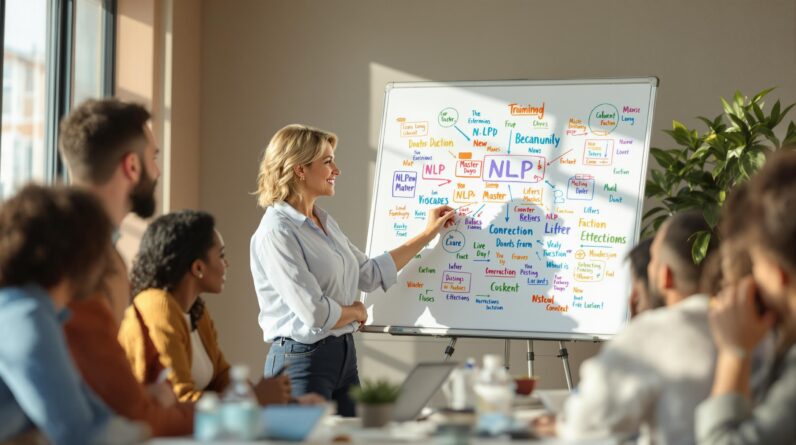
NLP Meta Programs are mental patterns that shape how we think, make decisions, and communicate. They act as filters, influencing what we notice, how we process information, and how we respond. Key insights include:
- Filters for Thinking: Meta Programs decide what grabs our attention and how we interpret situations.
- Shaping Decisions: They guide whether we focus on goals (Towards) or avoiding risks (Away From).
- Flexible Patterns: Unlike fixed traits, Meta Programs can change with context.
Quick Overview of Common Meta Programs:
- Towards vs. Away From: Goal-driven vs. risk-avoiding motivation.
- Big Picture vs. Detail-Oriented: Strategic thinkers vs. detail-focused planners.
- Internal vs. External Feedback: Relying on self-judgment vs. seeking external validation.
Understanding these patterns can improve communication, decision-making, and personal growth. Let’s explore how they work and how to apply them in daily life.
NLP Meta Programs: How we See the World
What Are NLP Meta Programs?
NLP Meta Programs act like your brain’s operating system, shaping how you think, process information, and make decisions. They influence how you perceive the world and interact with it daily.
Here’s what they impact:
How You Process Information: Meta Programs filter the sensory data you take in, deciding what grabs your attention and what gets ignored. Think of it like an email filter that separates important messages from spam.
Your Decision-Making Style: These programs guide how you evaluate choices. For example, when considering a career change, one person might focus on exciting opportunities (towards motivation), while another might focus on avoiding risks (away motivation).
Interestingly, Meta Programs can shift depending on the situation. For instance, you might prioritize details at work but prefer big-picture thinking in your personal life [2][4]. This flexibility makes them useful for both personal and professional development.
Meta Programs influence three main areas:
- Work life: Shaping how you approach projects and what roles suit you best
- Personal decisions: Affecting how you make choices and seek validation
- Motivation: Guiding how you set goals and solve problems
Understanding your Meta Programs can help you:
- Communicate more effectively
- Make decisions that align with your natural tendencies
- Adjust your behavior to achieve better results
Think of them as your mind’s default settings. While they’re pre-set, you can tweak them once you know how they work. This awareness can boost your self-understanding and improve how you connect with others who may see the world differently [1][3].
Why Do Meta Programs Matter?
Meta Programs influence nearly every aspect of our lives, from decision-making to how we connect with others. By understanding these mental filters, you can gain insights that drive better outcomes both personally and professionally.
Better Self-Awareness
Recognizing patterns like "away from" motivation helps explain why we make certain choices. This kind of awareness lays the groundwork for growth and smarter decisions, allowing for more effective behavioral strategies.
Stronger Communication Skills
Meta Programs can help you tailor your message to resonate with different audiences. For instance, when pitching a project, you might focus on detailed steps for detail-oriented colleagues while providing broader overviews for those who prefer big-picture thinking.
Here’s how Meta Programs play a role in key areas:
| Area | Impact | Practical Application |
|---|---|---|
| Decision Making | Shapes evaluation criteria | Aligns choices with natural thought processes |
| Team Dynamics | Affects collaboration styles | Improves task delegation and role assignments |
| Personal Growth | Highlights behavioral tendencies | Guides focused self-improvement efforts |
Professional Growth
In the workplace, Meta Programs can improve team dynamics, leadership effectiveness, project management, and client relationships.
Coaching and Development
For coaches, understanding Meta Programs is a tool to uncover clients’ thinking patterns and design personalized strategies for growth [2][4].
Cross-Cultural Communication
Meta Programs also help bridge cultural divides. For example, in global teams, recognizing whether someone prefers direct or indirect communication can reduce misunderstandings and enhance collaboration.
Practical Benefits:
- Reduce communication barriers
- Improve decision-making
- Strengthen teamwork
- Support personal development
It’s worth noting that Meta Programs aren’t fixed traits. They’re flexible patterns that can shift depending on the situation [2]. This adaptability makes them a powerful tool for both personal and professional growth, as you can adjust your approach to meet specific goals.
Next, let’s dive into specific Meta Program patterns and how they shape behavior.
The Origins of NLP Meta Programs
Meta Programs were first introduced in the 1970s during the development of Neuro-Linguistic Programming (NLP) by Richard Bandler and John Grinder. These mental patterns emerged as researchers noticed how differences in decision-making were shaped by higher-level thought processes, which they later termed Meta Programs.
Leslie Cameron-Bandler, alongside NLP pioneers like David Gordon and Robert Dilts, documented the initial set of these mental patterns. They found that these filters consistently influenced behavior across various situations. Robert Dilts further expanded the concept by showing how these patterns could be applied in diverse areas, including workplace dynamics and coaching practices [2].
Throughout the 1980s, the concept evolved from its early theoretical roots into practical tools. L. Michael Hall later demonstrated that Meta Programs could be adjusted using cognitive reframing techniques, proving them to be more adaptable than initially thought [2]. This discovery shifted earlier views and introduced new opportunities for personal and professional development.
Unlike traditional psychological profiling methods, Meta Programs can be identified through observing verbal and non-verbal cues [3]. This makes them practical and accessible tools for improving communication, refining coaching methods, and enhancing interpersonal interactions.
These early developments laid the groundwork for how Meta Programs are used today, influencing fields like personal development and organizational leadership. With this background in mind, we can now delve into specific Meta Program patterns and their role in shaping behavior.
Common NLP Meta Programs and How They Work
Meta Programs are unconscious patterns that influence how we behave, communicate, and make decisions. They help explain why people respond differently to the same situation [1].
Let’s look at three important Meta Programs that play a big role in shaping our daily actions and choices:
Towards vs. Away From Motivation
This pattern highlights how people approach goals. Some are driven by what they want to achieve (Towards), while others focus on avoiding what they don’t want (Away From). For instance, someone with a Towards mindset might aim for a promotion to gain new opportunities, while an Away From thinker might do the same to avoid feeling stuck [2].
| Orientation | Characteristics | Common Phrases |
|---|---|---|
| Towards | Goal-driven, opportunity-focused | "I want to achieve…", "My goals are…" |
| Away From | Risk-averse, problem-focused | "I want to avoid…", "I don’t want to…" |
Big Picture vs. Detail-Oriented Thinking
This pattern is crucial for effective communication and teamwork [4].
- Big Picture Thinkers: They focus on overarching ideas, make decisions quickly, and are great at planning strategies. However, they might overlook details.
- Detail-Oriented Thinkers: These individuals thrive on specifics, analyze thoroughly, and excel at execution, but they may struggle with broader concepts.
Recognizing these styles can help you adjust your communication. For example, when working with a team, you might share the vision with big-picture thinkers while breaking down specifics for detail-oriented colleagues.
Internal vs. External Feedback
This pattern shows how people evaluate their decisions and performance [2]:
- Internal Feedback: These individuals rely on their own judgment and internal standards. They prefer making independent decisions and may resist outside input.
- External Feedback: People with this pattern seek validation from others, value external opinions, and look to benchmarks for guidance. However, they might find it harder to act independently.
Understanding these tendencies can improve collaboration. For instance, when pitching a project, you might emphasize autonomy for someone who prefers internal feedback, while offering clear external validation for those who seek it [4].
These patterns aren’t fixed – they can shift depending on the situation and can be consciously adjusted with practice [2]. Next, we’ll dive into how to use these insights in everyday scenarios.
Motivation: Towards Goals or Away From Problems
Motivation plays a big role in shaping decisions and actions. It typically falls into two categories: moving towards goals or moving away from problems. People motivated by goals focus on opportunities, setting clear objectives and actively pursuing them. On the other hand, those driven by problem avoidance prioritize minimizing risks, sometimes at the expense of missing opportunities.
Here’s how these two patterns show up in everyday contexts:
| Context | Towards Motivation | Away From Motivation |
|---|---|---|
| Career | Aiming for promotions to grow | Working harder to avoid job loss |
| Health | Exercising to build strength | Exercising to prevent illness |
| Financial | Investing to grow wealth | Saving to avoid debt |
"When clients who have been using away-from thinking as a default for many years switch to toward as their default and ‘try it on’ for a number of weeks, they frequently describe it as if ‘a huge weight’ has been lifted from their shoulders." [2]
Practical Application
- Adjust goals to fit motivation styles: For goal-oriented individuals, use targets like "increase sales by 10%." For risk-averse individuals, emphasize objectives like "reduce customer churn."
- Personal development focus: Goal-driven people may aim to build confidence, while problem-avoiders often work on reducing self-doubt.
- Leadership strategies: Tailor communication to match team members’ motivational patterns for better engagement.
Understanding your dominant motivation style – and learning to adapt it when needed – can lead to more balanced decisions. For example, if you tend to focus on avoiding problems, try reframing goals in a positive light. This small shift can improve results in many areas of life [2][4].
Motivation patterns shape how we approach goals, just as thinking styles influence how we process and prioritize information in various situations.
Thinking Style: Big Picture or Detail-Focused
Big picture and detail-focused thinking represent two distinct ways people approach information and problem-solving. Big picture thinkers excel at understanding overarching concepts and identifying connections between elements. On the other hand, detail-focused thinkers thrive by dissecting complex situations into smaller parts and carefully analyzing each component.
Here’s how these styles play out in workplace scenarios:
| Context | Big Picture Thinker | Detail-Focused Thinker |
|---|---|---|
| Project Planning | Prioritizes strategy and overall timeline | Focuses on task breakdown and specifics |
| Problem-Solving | Spots patterns and systemic issues | Zeroes in on exact errors |
| Communication | Highlights vision and broader impact | Emphasizes technical details |
| Decision-Making | Weighs long-term outcomes | Analyzes immediate facts |
Adapting communication to suit these styles can improve teamwork. For example, when sharing project updates, a big picture thinker might need to see how tasks link to broader goals, while a detail-focused colleague may prefer specific metrics and actionable steps [4].
Practical Applications
You can improve problem-solving and tackle diverse challenges by developing both thinking styles:
- Big Picture Thinking: Link individual tasks to larger goals and focus on strategic planning.
- Detail-Focused Thinking: Use tools to break down complex projects and monitor progress through measurable outcomes.
By recognizing the value of both approaches, teams can combine strategic insight with precise execution, leading to more effective collaboration [1][4].
Understanding thinking styles is just one piece of the puzzle. Decision-making patterns show how we evaluate and act on the information we process.
Decision-Making: Internal or External Feedback
How we prefer to process feedback plays a big role in shaping our decisions. The internal/external feedback Meta Program highlights whether someone leans more on their own judgment or looks to others for validation when deciding.
Internal Decision-Makers
People with an internal feedback approach tend to trust their own instincts and rely heavily on personal experiences. They prefer to evaluate success by their own standards and often make decisions independently, avoiding unsolicited advice.
External Decision-Makers
On the flip side, external decision-makers actively seek input from others. They value social proof and thrive in collaborative environments. Before reaching a conclusion, they gather insights from trusted sources and experts.
| Aspect | Internal Feedback | External Feedback |
|---|---|---|
| Decision Speed | Often quicker | May take longer due to consultation |
| Information Sources | Personal experience and values | Outside opinions and data |
| Validation Method | Self-assessment | External confirmation |
| Challenge Areas | Might miss external perspectives | Could struggle with independence |
Practical Applications
The best decision-makers know when to trust their own judgment and when to consider outside input. Striking a balance between these approaches can lead to better outcomes. In the workplace, understanding these tendencies allows leaders to tailor their communication and decision-making strategies to fit their team’s preferences [2].
Using NLP Meta Programs in Daily Life
Let’s look at how you can apply Meta Programs in everyday life to improve communication, decision-making, and relationships.
Recognizing Your Own Patterns
Do you focus more on avoiding problems or chasing goals? This simple question can reveal your motivational tendencies. Knowing this about yourself helps you make more deliberate and informed choices.
Improving Communication and Relationships
Understanding Meta Programs can make a big difference in how you connect with others. Here’s how they play out in various settings:
| Context | Meta Program Pattern | How to Approach It |
|---|---|---|
| Work Presentations | Big Picture vs. Detail | Mix broad overviews with essential details to engage everyone. |
| Personal Relationships | Internal vs. External Processing | Match your feedback style to how the other person processes information. |
| Team Projects | Towards vs. Away From | Align goals with what motivates each team member. |
Making Smarter Decisions
Your natural tendencies might lean one way, like heavy self-reflection or seeking external input. To make better decisions, balance your usual approach with its opposite – this helps you see the bigger picture and avoid blind spots.
"Meta Programs are mental processes which manage, guide and direct other mental processes. In other words, they are processes about or at a higher level than other mental processes." – John David Hoag [2]
Practical Tips for Everyday Use
In workplace settings, tailor your feedback style to match how others process information. For example, give internal processors time to reflect, while external processors might prefer a direct discussion. When working with teams:
- Blend broad strategies with specific data to cater to different preferences.
- Adjust your presentation style based on your audience.
- Frame messages in ways that resonate with their motivation, whether goal-focused or problem-avoidant.
Tackling Challenges
Sometimes your default patterns won’t work in a given situation. Practicing new approaches can help you adapt and find better ways to handle challenges [1].
Staying Flexible
Meta Programs aren’t set in stone – they can shift depending on the situation [2]. Learning to adjust your patterns to suit different contexts strengthens both your communication and your relationships [4]. This adaptability opens up new opportunities for growth and connection.
sbb-itb-d87b7ee
Improving Self-Awareness and Growth
Understanding your Meta Programs can open up new ways to grow and improve yourself. Here’s how you can use this knowledge to make meaningful changes.
Identifying Your Current Patterns
Take a closer look at how you usually process information and make decisions. For example, if you often rely on others’ opinions before deciding, you might have an external feedback Meta Program [2].
Making Conscious Shifts
Adjusting your Meta Programs can lead to noticeable improvements in how you approach personal growth:
| Meta Program Shift | How It Helps | Real-World Example |
|---|---|---|
| Away From → Towards | Encourages goal-oriented actions | Focus on what you want to achieve instead of what you’re avoiding |
| External → Internal | Builds confidence in your choices | Balance advice from others with your own judgment |
| Details → Big Picture | Enhances strategic thinking | Think about the overall impact, not just the specifics |
Developing New Perspectives
Learning to adjust your Meta Programs helps you break free from old habits, giving you a broader view of situations and opportunities.
Creating Growth Opportunities
Meta Programs shape how you filter and understand information [2][4]. To grow and improve your relationships, try these approaches:
- Experiment with changing your default patterns in less critical situations.
- Combine personal reflection with feedback from others.
- Track how small adjustments to your patterns influence outcomes.
- Adapt how you communicate to better connect with others’ perspectives.
- Use tools like journaling or feedback loops to stay aware of your progress.
Overcoming Growth Barriers
Regularly reflecting on your Meta Programs can help you spot when they’re helping or holding you back. Work on expanding your range of responses while staying true to your natural tendencies [2][4].
Better Communication Through Meta Programs
Meta Programs are a way to understand how people process information and make decisions. By recognizing these patterns, you can improve how you interact and communicate with others.
Recognizing Patterns
Pay attention to how people talk about their goals or challenges. Their word choices and phrasing can reveal their preferred ways of thinking and communicating [2].
Communication Strategies
Adjust your communication style to align with someone’s Meta Programs:
| Communication Need | Suggested Approach |
|---|---|
| Vision-Focused | Highlight the bigger picture and outcomes. |
| Detail-Focused | Offer clear, step-by-step information. |
| Self-Directed | Ask for their input and ideas. |
| External Validation | Share examples or feedback from others. |
Strengthening Professional Relationships
In the workplace, understanding these patterns can reduce misunderstandings and improve teamwork. When colleagues appreciate each other’s communication styles, collaboration becomes smoother and more productive [4].
Practical Tips for Adapting
- Match Their Style: Notice if they prefer big-picture ideas or detailed discussions. Adjust how you present information to connect better [2][4].
- Support Their Decisions: Identify if they rely on personal judgment or look for external confirmation. Tailor your approach to fit their decision-making process [2][3].
- Speak to Their Motivation: Frame your message to resonate with their natural motivators, while staying genuine [2].
Enhancing Team Dynamics
Pairing people with complementary styles can lead to well-rounded solutions. For instance, pairing detail-oriented individuals with those who focus on the bigger picture can create more balanced outcomes [4].
Common Pitfalls to Avoid
To make the most of Meta Programs, keep these points in mind:
- Observe carefully before drawing conclusions about someone’s preferences.
- Stay flexible and adjust your approach as needed.
- Consider the context, as Meta Programs can vary depending on the situation [2][3].
People’s preferences aren’t set in stone – they can change based on circumstances. Regularly reassess and refine your understanding of others’ communication styles [3].
Applying NLP Meta Programs at Work and in Coaching
Understanding NLP Meta Programs can help professionals improve workplace dynamics and achieve better coaching results. Here’s how they can be applied in practical ways.
Workplace Implementation
Meta Programs are useful for improving task delegation and building effective teams. When managers recognize their team members’ Meta Programs, they can make smarter decisions in areas like:
| Area | Strategy | Outcome |
|---|---|---|
| Task Assignment | Match tasks to individual thinking styles | Boosts productivity and engagement |
| Team Formation | Combine complementary Meta Programs | Encourages balanced solutions and creativity |
| Goal Setting | Align goals with motivation styles | Drives better performance and satisfaction |
Coaching Applications
Coaches can use Meta Programs to better understand their clients’ thought processes and tailor their guidance accordingly. This approach helps uncover unique patterns and encourages personalized growth strategies.
"Meta Programs operate to determine which of our perceptions are selected for attention and represented internally from among a vast array of inbound sensory data" [2]
Leadership Enhancement
Leaders benefit from using Meta Programs to:
- Build well-rounded teams by pairing individuals with different working styles, like independent thinkers and team-oriented collaborators.
- Encourage creative problem-solving by embracing diverse approaches.
- Resolve conflicts by recognizing and addressing varying perspectives [4].
Training Integration
Organizations can include Meta Programs in training programs by assessing team members’ thinking patterns, practicing exercises to identify these patterns, and tracking progress through feedback and performance metrics.
Ethical Considerations
It’s important to use Meta Programs responsibly. Respect individual preferences, avoid manipulative practices, and ensure that all interactions benefit everyone involved [2][4].
Improving Teamwork and Leadership at Work
Using insights from Meta Programs, leaders can create stronger teamwork and improve leadership effectiveness. Let’s dive into actionable ways to make this happen.
Understanding Team Dynamics
Meta Programs shape how people process information and make decisions. By identifying these patterns, leaders can cater their approach to individual team members. For instance, detail-focused team members thrive with clear instructions and measurable goals, while those who prefer the big picture respond better to strategic overviews.
| Meta Program Type | Leadership Approach | Team Impact |
|---|---|---|
| Towards Motivated | Highlight goals and opportunities | Encourages creativity and initiative |
| Away From Motivated | Address risks and ensure safeguards | Strengthens quality and risk management |
| Internal Reference | Offer independence in decision-making | Builds confident, self-reliant leaders |
| External Reference | Use collaborative feedback systems | Boosts team alignment and coordination |
Tailoring Communication Styles
Leaders can connect better by observing how team members think and adjusting their communication accordingly. This ensures messages resonate and improves overall engagement. Tracking how these adjustments impact outcomes can help refine the approach.
Conflict Resolution
Meta Programs also provide a framework for resolving conflicts. Differences in how individuals process information can lead to misunderstandings. By recognizing these patterns, leaders can mediate disputes more effectively, turning diverse perspectives into team strengths. This approach reduces friction and keeps the focus on productivity and collaboration.
Practical Implementation
The key to success lies in regularly evaluating team interactions and adjusting leadership strategies to fit individual needs. Leaders can also encourage collaboration by pairing team members with complementary Meta Programs. These techniques work well for both group settings and one-on-one coaching.
It’s important to note that Meta Programs are not set in stone – they’re flexible and can evolve over time [2]. Leaders can guide team members to adapt their thinking styles for specific challenges, helping them grow and perform better in their roles.
Helping Clients Through Coaching
NLP Meta Programs provide coaches with effective tools to better understand and guide their clients. By recognizing these unconscious patterns, coaches can design personalized strategies that align with how each client processes information and makes decisions.
Identifying Client Patterns
By asking targeted questions and listening carefully, coaches can uncover their clients’ Meta Programs. This insight helps reveal thought patterns and allows for tailored coaching approaches.
| Meta Program Focus | Assessment Questions | Coaching Application |
|---|---|---|
| Motivation Direction | "What drives you to pursue this goal?" | Match goal-setting techniques to the client’s motivational style |
| Information Processing | "How do you prefer to receive new information?" | Adapt communication methods and activity formats |
| Decision Making | "What helps you know you’ve made the right choice?" | Create feedback methods that suit the client’s decision-making process |
Tailoring Coaching Approaches
Different clients benefit from different coaching techniques. Adjust your strategies based on their preferences and strengths.
| Client Type | Coaching Strategy |
|---|---|
| Detail-Oriented | Break goals into clear, actionable steps |
| Big-Picture Thinkers | Emphasize vision and long-term strategies |
| Internal Reference | Focus on self-reflection and personal standards |
| External Reference | Use peer input and measurable outcomes to guide progress |
Boosting Client Self-Awareness
Coaches can help clients recognize their own Meta Programs, showing how these patterns influence their decisions and behaviors. This awareness empowers clients to make more effective choices and achieve their goals.
Practical Implementation Strategies
During coaching sessions, pay close attention to how clients express themselves. For instance, if a client talks about avoiding problems, encourage them to frame goals in positive terms. This shift can lead to more constructive outcomes.
Measuring Progress
Track progress by observing changes in thought patterns, decision-making, and goal achievement. Use client feedback to gauge effectiveness and refine approaches.
Keep in mind that Meta Programs are not fixed – they can shift depending on the context [2]. This adaptability allows coaches to help clients build more productive patterns while respecting their natural tendencies.
Conclusion
Meta Programs, as explored in detail, play a crucial role in shaping how we interpret and respond to the world around us. These mental filters influence behavior and decision-making, offering insights that can lead to growth in both personal and professional spheres.
By understanding Meta Programs, individuals can better grasp their own tendencies and those of others. This knowledge allows for more effective communication, decision-making, and relationship-building. In professional environments, leaders who apply these concepts can adjust their communication styles to boost team performance. Similarly, coaches can guide clients to recognize their natural patterns and develop improved approaches.
| Application Area | Benefits | How to Implement |
|---|---|---|
| Self-Development | Greater self-awareness and clarity | Reflect on personal thought and behavior patterns |
| Professional Growth | Stronger leadership and communication | Adjust management approaches to team dynamics |
| Coaching and Mentoring | Better client outcomes | Customize strategies based on client tendencies |
For those eager to dive deeper, certified NLP training, observation of Meta Programs in everyday interactions, and consistent practice are excellent ways to strengthen this skill set [1][2].
Key Points to Remember
Meta Programs play a major role in shaping how we perceive, decide, and act. To grasp the concept of Meta Programs, focus on three essential aspects:
Meta Programs act as mental filters, influencing how we process information, set goals, and react to feedback. Common patterns include Towards vs. Away From motivation, Big Picture vs. Detail focus, and Internal vs. External decision-making. These patterns uniquely affect behavior [1][2].
These patterns are impactful across various areas:
| Domain | Application | Key Outcome |
|---|---|---|
| Personal Development | Recognizing personal patterns | Better self-awareness |
| Professional Growth | Understanding team dynamics | Stronger leadership |
| Communication | Adjusting to others’ patterns | More effective dialogue |
"Meta Programs operate to determine which of our perceptions are selected for attention and represented internally from among a vast array of inbound sensory data" [2]
Learning about Meta Programs can boost self-awareness, leadership, and communication skills by helping people identify and adjust their thinking patterns. While these patterns are often unconscious, they can be intentionally adjusted, making them useful tools for both personal and professional growth [2][4].
Robert Dilts highlights that the purpose of Meta Programs is to understand different thinking styles, not to categorize or stereotype individuals. This perspective fosters more effective personal development and stronger professional relationships [2].
With this foundation, let’s dive into how you can apply Meta Programs in practical, everyday scenarios.
Where to Learn More
If you’re looking to expand your knowledge of NLP Meta Programs, there are plenty of resources to explore.
Books to Check Out
One standout resource is The Encyclopedia of Systemic Neuro-Linguistic Programming and NLP New Coding by Robert Dilts and Judith DeLozier. This book dives deep into Meta Programs and is a great pick for both beginners and seasoned practitioners [2].
Online Learning Platforms
| Platform | Features |
|---|---|
| NLP World | Offers interactive workshops and case studies for hands-on learning |
| NLP Coaching Academy | Combines theory with practice through certification programs |
| NLP Yourself | Provides self-paced courses with practical exercises |
Specialized Training
The NLP Coaching Academy offers targeted training that incorporates Meta Programs into coaching. These programs blend theoretical concepts with practical applications, making them ideal for professionals [1][2].
Digital Articles and Case Studies
NLP World curates a library of articles and case studies, updated regularly with insights and research. Their content highlights practical uses of Meta Programs across various fields [5].
Ongoing Learning Opportunities
Join NLP forums, sign up for newsletters, or attend certified workshops and webinars to stay current. These options help you refine your understanding and keep your skills sharp [1][5].
These tools and resources are a great starting point for anyone aiming to master NLP Meta Programs, whether for personal growth or professional use.
FAQs
What are away-from and towards motivation strategies?
Away-from motivation is about avoiding negative outcomes, while towards motivation focuses on achieving positive goals. These are key concepts in NLP Meta Programs that shape how we approach goals.
Away-from motivation can kickstart action but often loses steam over time. In contrast, towards motivation builds strength as you get closer to your goals. Knowing how these patterns work can help you create better strategies for reaching your objectives.
"A person might have one Meta Program operating in one context, and its opposite operating in another." – John David Hoag, NLP Meta Programs [2]
How to Use These Strategies: Away-from motivation is great for avoiding problems and taking immediate action, but it doesn’t last long. Towards motivation keeps you focused and energized as you make progress. The best approach? Combine the two: start with away-from motivation to get moving, then switch to towards motivation to stay on track [2][4].
Tips for Success:
- Identify your main motivation style.
- Use both strategies for better results.
- Adjust your approach based on the type of goal and timeline.
- Track your progress to keep your motivation alive.
These motivation patterns highlight how Meta Programs shape decisions and goal-setting. By understanding and blending these strategies, you can align your goals with your natural tendencies while working toward long-term success [1][2].
This insight is especially useful in personal growth and professional coaching, where recognizing and adapting to motivation styles can lead to better outcomes [2][4].
Related posts
- NLP vs Traditional Coaching: Key Differences Explained
- 5 NLP Exercises to Boost Workplace Productivity
- Top 8 NLP Books for Personal Development
- Step-by-Step Guide to NLP Self-Training Success







